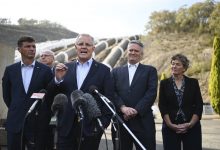Prime minister Scott Morrison and energy minister Angus Taylor have been leading Australians into an Alice-in-Wonderland world where – at least in regard to greenhouse gas emissions – up is down and down is up.
Both Morrison and Taylor have been caught cold lying about Australia’s emissions trajectory. “Emissions are going down,” Taylor insisted on ABC’s Insiders program on Sunday.
“Australia’s emissions are projected to grow 1 per cent above current levels to 2020,” the government department says in official forecasts. “Emissions to 2030 are projected to grow 4 per cent above 2020 levels.”
The Coalition is taking a similarly cavalier approach to the facts when talking about the costs of various energy sources, and its insistence that having more coal in the system can, somehow, lower the cost of power to consumers.
Helpfully, as the Coalition was announcing the injection of another $1.4 billion into the un-costed Snowy 2.0 pumped hydro scheme, the CEO of the federal government’s wholly owned subsidiary Snowy Hydro, Paul Broad, was on hand to point out some real facts about the cost of wind and solar versus coal.
For a start, Broad noted, the recent tender for 888MW of wind and solar conducted by Snowy Hydro had elicited an average bid of just $40/MWh.
This, Broad said, compared to the existing cost of coal – which on fuel costs alone needed a power price of $56/MWh to break even. (Full transcript is here).
Just to repeat, $40/MWh for wind and solar, all in, and $56/MWh for coal, just the fuel costs, not including the cost of maintenance and the capital cost to build anything new.
If that wasn’t a big enough slap down of the Coalition’s miserable defence of coal, Broad went further, saying that the cost of “firming” that wind and solar output would be well below the current wholesale price of electricity, which as the Australian Energy Market Operator recently concluded, has recently set by black coal, which is why wholesale prices are at record highs.
Broad said the total cost of wind and solar was less than $70/MWh, and would likely be less than $60/MWh.
“As renewable is coming in, the prices are coming down,” Broad told journalists as Morrison and Taylor stood there grinning on the outside.. “As we said the other day when we did the deal on renewables and firmed it up, so that’s equivalent to baseload, we firming that in sub-seventy. We think that price is going to look like sub-sixties.”
Just let that final number sink in for a bit: sub-sixties for wind and solar plus firming. That means that the total cost of wind and solar plus firming is about the same as the fuel cost only for existing coal generators. Remarkable, and it goes to support the CSIRO and AEMO’s estimates that wind and solar plus storage is way cheaper than new fossil fuel generators.
Despite this, Morrison and Taylor and Resources minister Matt Canavan would have us believe that shovelling yet more taxpayer funds into an underwriting contract for new coal generation might somehow be a good idea.
The government is siting on 66 proposals for such funds, including 10 from coal generators.
It has yet to even conduct the next stage of the process, a more concrete request for proposals, yet in their haste to be seen to be doing something, Morrison has already promised a contract to Hydro Tasmania for a project that has no name, no location, no capacity, no model, no nothing.
Which gets us back to the numbers that would underpin either Snowy 2.0 or the Tasmania “battery of the nation” pumped hydro project.
Snowy Hydro and the government have refused to reveal how the numbers stack up. But Broad, in that same press conference, gave an indication of how Snowy Hydro would like the numbers to stack up.
The idea, he says, is to play the arbitrage – buying wind and solar at around $40/MWh and selling at the peaks at around $100/MWh. Even better, Snowy could buy at “negative” prices when the market dips below zero.
But these occasions are rare, and they won’t stay long under zero with a big buyer like Snowy 2.0 in the background. And while the wind and solar plants providing output at $40/MWh are great, it will need bucketloads more wind and solar to fill in the huge demand of a project with 2,000MW of capacity and 175 hours of storage.
(Snowy says that the wind and solar contracted will deliver more than half the power it needs to pump water up hill, but this is based on the whole scheme operating at less than one quarter of its capacity out to 2030).
And this is where the push for the Snowy scheme runs out of puff. Snowy wouldn’t even reveal who won those wind and solar contracts. And when identified, the winning contractors would not reveal the name of the projects. The suspicion of some in the industry is that some of these projects may have not even been identified, or got planning or connection approval.
Worse, the Coalition won’t support the very changes that are required to ensure that either Snowy 2.0 or the Tassie battery of the nation make money: namely that the exit of existing coal generators needs to be accelerated rapidly, and the NEM needs to move very quickly to a renewables dominated market.
The Coalition would like us to believe that this would crash the economy and be the end of civilisation as we know it.
The tragedy is that without that increase in wind and solar, neither pumped hydro mega project makes sense, and on Broad’s own numbers, and the modelling done for both Snowy Hydro and Tas networks, and by AEMO, it will result in more coal generation and that will simply mean that we will pay more for electricity, not less, and we generate way more emissions.
Why is this so hard to understand?










